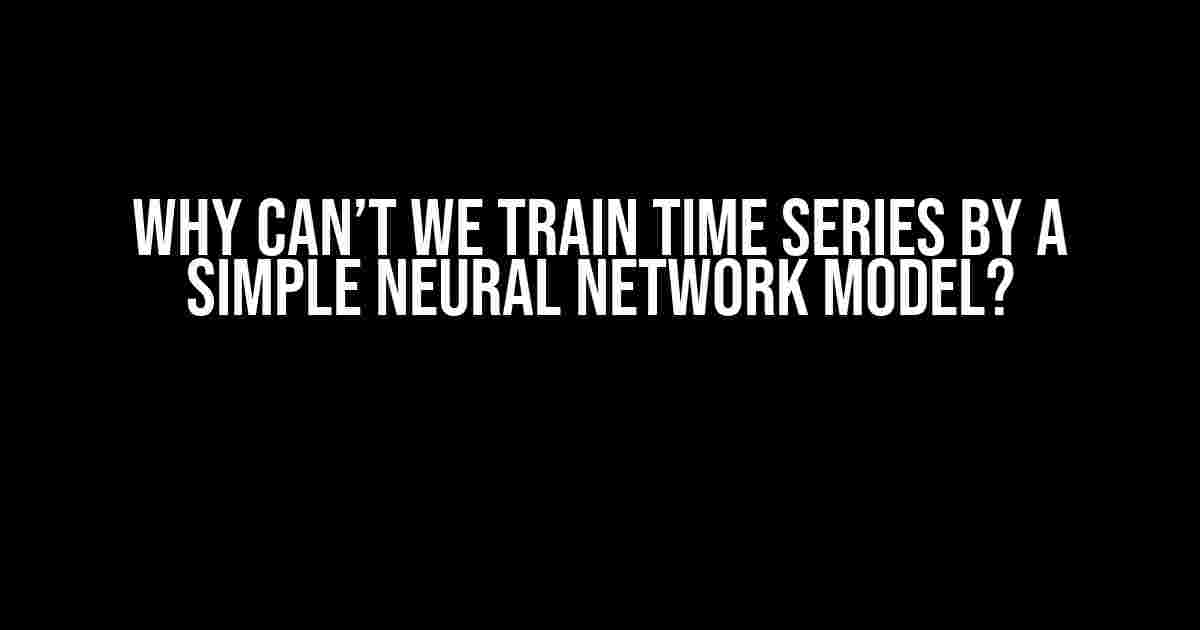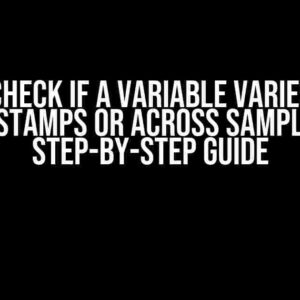As machine learning enthusiasts, we’ve all been there – staring at a time series dataset, wondering why our simple neural network model just won’t converge. We’ve tweaked the hyperparameters, added more layers, and even tried different optimizers, but nothing seems to work. So, what’s going on? Why can’t we train time series by a simple neural network model?
The Problem with Time Series Data
Time series data is unique in that it’s inherently sequential. Each data point is dependent on the previous one, and this temporal relationship is crucial to understanding the underlying patterns. However, this sequential nature also makes time series data notoriously difficult to work with.
Autocorrelation and Stationarity
One of the main challenges with time series data is autocorrelation – the tendency of a variable to be correlated with its past values. This autocorrelation can lead to complex patterns that are difficult for simple neural networks to capture. Additionally, time series data often exhibits non-stationarity, meaning that the patterns and trends change over time. This non-stationarity can render traditional machine learning models ineffective.
Let’s take a look at an example:
import pandas as pd
import matplotlib.pyplot as plt
# Load the data
df = pd.read_csv('daily_temperatures.csv', index_col='date', parse_dates=['date'])
# Plot the data
plt.plot(df.index, df['temperature'])
plt.xlabel('Date')
plt.ylabel('Temperature (°C)')
plt.title('Daily Temperatures')
plt.show()
This plot shows daily temperature readings over a year. Notice how the temperatures are highly autocorrelated, with daily fluctuations and seasonal patterns. A simple neural network would struggle to capture these complex relationships.
Why Simple Neural Networks Fail
So, why can’t we train time series by a simple neural network model? There are several reasons:
- Lack of temporal context: Simple neural networks are designed to process independent and identically distributed (i.i.d.) data. However, time series data is inherently sequential, and each data point is dependent on the previous one. This lack of temporal context makes it difficult for simple neural networks to capture the underlying patterns.
- Insufficient feature extraction: Time series data often requires specialized feature extraction techniques to capture the underlying patterns. Simple neural networks may not be able to extract these features effectively, leading to poor performance.
- Overfitting and underfitting: Time series data can be susceptible to overfitting and underfitting, especially when using simple neural networks. Overfitting occurs when the model is too complex and memorizes the training data, while underfitting occurs when the model is too simple and fails to capture the underlying patterns.
Alternatives to Simple Neural Networks
So, what can we do instead? Here are some alternatives to simple neural networks for training time series data:
- Recurrent Neural Networks (RNNs): RNNs are specifically designed to handle sequential data and can capture the temporal relationships in time series data. They’re particularly useful for forecasting and prediction tasks.
- Long Short-Term Memory (LSTM) Networks: LSTMs are a type of RNN that’s particularly well-suited for time series data. They can learn long-term dependencies and capture complex patterns.
- Transformers: Transformers are a type of neural network that’s primarily used for natural language processing tasks. However, they can also be applied to time series data, especially when combined with other techniques like convolutional neural networks (CNNs).
- AutoRegressive Integrated Moving Average (ARIMA) Models: ARIMA models are a type of statistical model that’s specifically designed for time series forecasting. They can capture trends, seasonality, and other patterns in the data.
Best Practices for Training Time Series Models
So, what can we do to improve our chances of success when training time series models? Here are some best practices:
- Preprocess the data: Time series data often requires preprocessing techniques like normalization, detrending, and differencing to make it more tractable for modeling.
- Split the data wisely: Split the data into training, validation, and testing sets, taking care to maintain the temporal relationships between the data points.
- Choose the right model: Select a model that’s well-suited to the problem at hand, taking into account the characteristics of the data and the task requirements.
- Tune the hyperparameters: Hyperparameter tuning is crucial for time series models. Use techniques like grid search, random search, or Bayesian optimization to find the optimal hyperparameters.
- Monitor and evaluate the model: Monitor the model’s performance on the validation set and evaluate its performance on the testing set using metrics like mean absolute error (MAE) or mean squared error (MSE).
Conclusion
Training time series data using a simple neural network model can be challenging due to the unique characteristics of time series data. However, by understanding the limitations of simple neural networks and using alternative models and techniques, we can improve our chances of success. By following best practices and choosing the right model for the task, we can unlock the potential of time series data and make accurate predictions and forecasts.
| Model | Description |
|---|---|
| Simple Neural Network | A basic neural network with a single hidden layer |
| Recurrent Neural Network (RNN) | A neural network designed to handle sequential data |
| Long Short-Term Memory (LSTM) Network | A type of RNN that can learn long-term dependencies |
| Transformer | A neural network primarily used for natural language processing tasks |
| AutoRegressive Integrated Moving Average (ARIMA) Model | A statistical model used for time series forecasting |
Remember, the key to success lies in understanding the characteristics of time series data and choosing the right model and techniques for the task at hand. By doing so, we can unlock the potential of time series data and make accurate predictions and forecasts.
Frequently Asked Question
Time series forecasting is a complex task, and using a simple neural network model may not be enough to produce accurate results. Here are some reasons why:
Why can’t I just use a simple neural network to train my time series data?
A simple neural network assumes that the input data is independent and identically distributed, which is not the case for time series data. Time series data has temporal dependencies, seasonality, and trends that need to be considered.
Isn’t a neural network supposed to learn patterns from data?
Yes, neural networks are great at learning patterns, but they need to be designed specifically for time series data. Simple neural networks are not equipped to handle the complex patterns and relationships present in time series data.
What about using a recurrent neural network (RNN)?
RNNs are a step in the right direction, but they can still struggle with long-term dependencies and suffer from vanishing gradients. More specialized architectures like LSTMs and GRUs are often needed to model complex time series data.
Can I just use a large enough neural network to memorize the time series data?
No, even a large neural network will struggle to memorize time series data. This approach would lead to overfitting, and the model would not generalize well to new, unseen data.
What’s the best approach for training a time series model then?
The best approach involves using specialized architectures and techniques designed for time series data, such as ARIMA, Prophet, or LSTM-based models. Additionally, incorporating domain knowledge, feature engineering, and hyperparameter tuning are crucial for achieving accurate results.


